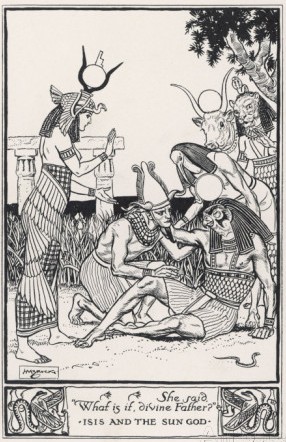
As we approach the time when night and day, moon and sun come into a brief and beautiful balance, let’s talk about Isis’ lunar and solar natures.
Many modern people first think of Isis as a Moon Goddess. And, it’s true, in later periods of Her worship, She was indeed associated with the moon—and, in fact, that’s how She entered the Western Esoteric Tradition. Yet, this Isis-moon connection isn’t all that new. It first started when Egypt came under Greek rule in the 3rd century BCE, following the conquest by Alexander the Great. To the Greeks, Goddesses were the lunar Deities, so as Isis made Her way into Greek culture and hearts, Her new devotees naturally associated Her with the moon.
But in Egypt, Osiris, Khons, Thoth, and I’ah were the Deities most associated with the moon. Isis, for Her part, was connected with the star Sirius as far back as the Pyramid Texts; the star was said to be Her ba, or soul. Yet Isis is also linked with the sun.
As the Sun was the image of one of the most important Gods to the ancient Egyptians, it should not be surprising to find that Isis, one of the most important Goddesses, also has strong solar connections. In some places—notably, Her famous temple at Philae—Isis was worshipped specifically as a Sun Goddess. Among Her solar epithets are Female Re (Re-et) and Female Horus (Horet).
Isis’ most common solar manifestation is as the Eye of Re, the Uraeus, the Cobra Goddess Who coils upon the Sun God’s brow to protect Him; and Who fights a constant cosmic battle against His great opponent, Apop (Gr. Apophis). An inscription at Philae calls Isis “Neseret [fiery]-serpent on the head of Horus-Re, Eye of Re, the Unique Goddess, Uraeus.” A hymn from Philae calls Her “Eye of Re who has no equal in heaven and on earth.” The Eye of Re is His active power. While He maintains His place in the sky, the solar power—the Eye Goddess—goes forth to manifest His Divine will. In this way, Isis and the other Uraeus Goddesses (such as Nephthys, Wadjet, and Tefnut) are similar to Shakti, the active, feminine Power related to the God Shiva in some Hindu sects. Isis is also one of the Deities Who travels with Re in His solar barque as it moves through the Otherworld. Again, Her function is to protect Him and help battle His foes.
Isis is also associated with the Sun God and the Sun in several of Her important myths. In the tale of Isis and Re, Isis gains power equal to Re’s by learning His secret name, first by poisoning, then by healing the ailing God. In another, with Her magical Words of Power, Isis stops the Boat of the Sun in the sky in order to receive aid for Her poisoned child, Horus.
But it was at Isis’ influential temple at Philae that She was most clearly worshiped as a Sun Goddess and even as the Sun itself. A Philae hymn to Isis praises Her saying, “You are the one who rises and dispels darkness, shining when traversing the primeval ocean, the Brilliant One in the celestial waters, traveling in the barque of Re.” An inscription on the first pylon (gate) at Philae says Isis is the “One Who illumines the Two Lands with Her radiance, and fills the earth with gold-dust.” (Blissful sigh. I absolutely adore this praise of Her…She fills the earth with gold dust.)
Like many other Egyptian Deities, Isis was often envisioned with immortal, golden, solar skin. Some of Her sacred images would have been covered with gold, earning Her, like Hathor, the epithets The Gold and the Golden One. A Philae hymn addresses Her, “O Golden One; Re, the possessor of the Two Lands, will never be far from you.” Some scholars believe that the holy of holies at Philae may have once been gold-leafed so that it always appeared filled with golden, solar light. Wow; to bathe in Her gold dust there!
At Her Philae temple, Isis is first of those in heaven: “Hail to you, Isis, Great of Magic, eldest in the womb of her mother, Nuet, Mighty in Heaven Before Re.” She is the “Sun Goddess in the circuit of the sun disk” and Her radiance outshines even that of Re. At Denderah, She is the power of the sun: “She Who shines as the Right Eye during the day,” and “She Who rises everyday.” She is also the Aten, the Solar Disk itself.
From Her great temple at Philae, Isis’ identity as a Sun Goddess flowed back up the Nile to Her temples at Memphis and Isiopolis in the delta. From there, it entered into the Graeco-Roman culture in the famous aretalogies (self-statements) of Isis. From a papyrus found in Oxyrhynchus, Egypt, we learn that one of Isis’ many names is Name of the Sun and that She is responsible for the rising of the Sun: “Thou [Isis] bringest the sun from rising unto setting, and all the Gods are glad.” In an aretalogy from Kyme, in modern Turkey, Isis says of Herself, “I ordered the course of the sun and the moon.” And later in the same text She says, “I am in the rays of the sun” and “I inspect the courses of the sun.”
Yet even in Egypt itself, Isis is known to rule both sun and moon. An inscription from Denderah calls Her “the great female Ra in the dual course of the sun and the moon.” She gives birth to the Sun God and His Solar Disk, according to inscriptions now in the British Museum and the temple of Esna.
As a Great Goddess, Isis ever reveals more of Herself to Her devotees. We can see Her in the golden sun and in the silver moon…and of course, in diamond starlight, too.






